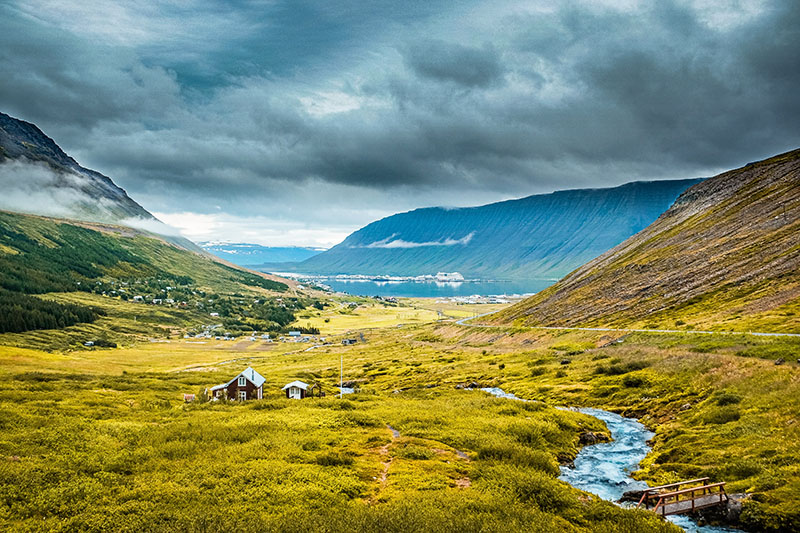My introduction to the Westfjords was to rolling country for the most part including even the fjords. But as I’ve driven farther, especially since Holmavik, the valleys and mountainsides have grown deeper and higher. This is how I imagined the whole vast (for Iceland) peninsula would be. When the roads are not tunneling through a mountain, they mostly hold to the coast so I find myself going up to the head of a fjord and then down to the mouth and then up and back again. There aren’t a lot of people out here but there are more than I expected. Isafjordur, which is two tunnels back east of the village where I’m staying (or one tunnel—it’s unique in that the tunnel has an intersection where I turned right for 3km after leaving Isafjordur and driving 2-3km into the tunnel; two-lane to the intersection and then one-lane afterwards) is a town of over 2,000 people, built, naturally, on a fjord in a dramatically beautiful location. It’s a real town and one could forget that he lived in virtually empty surrounding space as far as human presence and impingements were concerned. The village where I’m staying, Suòureyri, has about 200 people. In all these places I feel under the sway, or domination or ever-presence, of climate and geology. I don’t see how one could live here and lose that sense, although I’m sure people do, some just from habituation and easily recollected and others from blockheadedness. I like the feeling of it; it reminds me of when I drove through the Yukon and Alaska the first time and realized I was a small visitor to a large landscape, not exactly hostile but definitely one to respect. Wherever we live we are vulnerable to its climate and possibly other or related factors (earthquakes, tornadoes, hurricanes), but it’s the sense of Nature in its larger and stronger expressions—ocean, mountain, desert—that most attracts me. I certainly feel that here; it’s part of what would draw me to live here if I were younger and could manage it. It was blind ignorance on humans’ part to separate themselves from Nature and choose to think of it as something exterior and only usable rather than something to revere and live in accordance with. It has led not only to immense destruction but to psychic and spiritual emptiness. Incalculable loss in all dimensions.
The only thing lacking here compared to the Faroes is the small scale I so appreciated there, although I imagine on a people per acre basis Iceland’s more sparse than the Islands (not that population is the only factor). But it doesn’t feel it. Iceland is also a more diverse landscape; both though are quite beautiful and satisfy my soul. To live in an isolated village on an isolated island apart from the strivings of most of the present world…that’s something that should be preserved even while not isolating people from knowledge and cultural input from outside. It’s a balance that people are famously inept at managing. And the world won’t stay away if it thinks there’s money to be made here (and world will find those who dance to the same time locally). I can’t help feeling almost as I feel about the vanishing tribal people of the Amazon. What chance have they in a world that cares nothing about respecting otherness when there’s an opportunity to profit monetarily?
Photo by Joel Rohland on Unsplash


